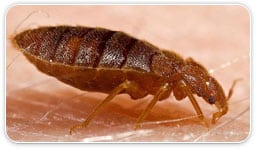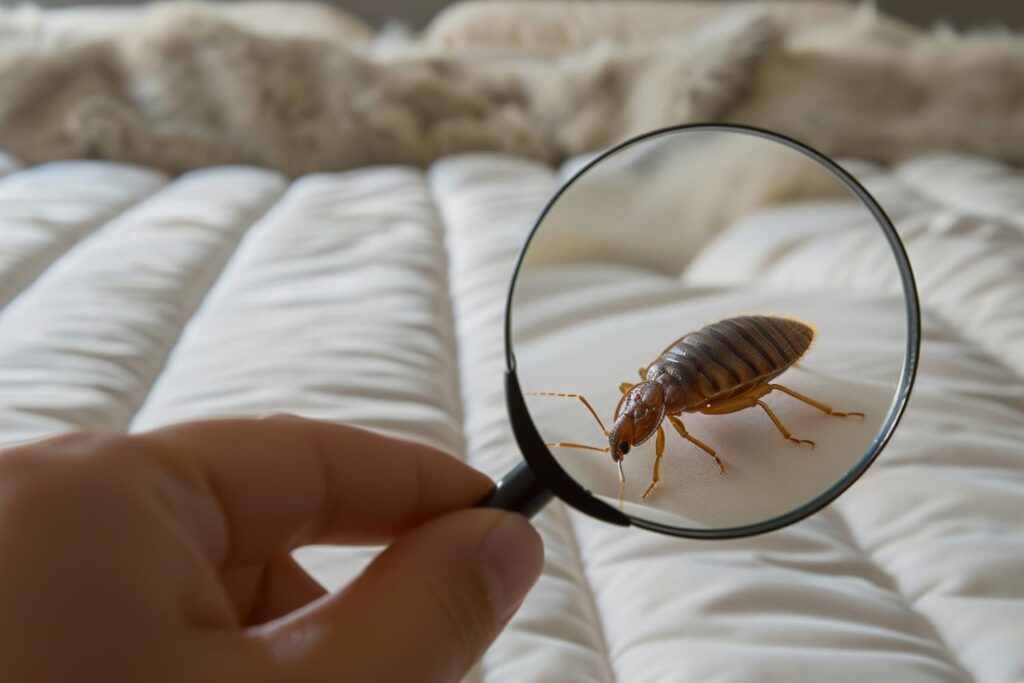Bed bugs are a threat that can ruin your house or place of business and cause extreme discomfort in your daily life. They like to take up residence behind picture frames, in electrical outlets, carpets, chairs, mattresses, and pillows.
Detecting bed bugs in your home can be challenging due to their shy nature and nocturnal habits. They can go up to three months without eating, but once they have young to feed, they will start to move around more.
If they have attacked you, you will most definitely be able to identify it since they leave marks on your body. Usually in a line or small clusters, those tiny nibbles often appear as red, itchy bumps.
If you believe you have a bed bug infestation in your home and need a bed bug exterminator in Long Island, NY, do not hesitate to contact Optimum Pest Control.
What Are Bed Bugs?
Bed bugs are tiny creatures, anywhere from 1/4 to 5/8 of an inch in size. They are reddish-brown, oval-shaped, and flat. They lurk in the nooks and crannies of a space, such as around outlets, molding, furniture, and carpet edges. Because these pests feed on the blood of people and animals, they typically remain as near to their host as possible.
Many times, people are unaware that they have bed bugs. People frequently mistakenly attribute the itching, allergies, difficulty sleeping, and other effects to something else because these insects are so tiny. But you can lessen the likelihood of bed bugs getting into your house if you know how to spot them and prevent them.
To obtain blood for sustenance, their mouthparts are pierced. Around 200 eggs are laid by female bed bugs, and they hatch in one to two weeks. It takes 4 to 8 weeks for newborn bed bugs to become ready to lay their eggs. Since they reproduce fast it is hard to deal with a bed bug infestation without professional assistance.
 How to Identify Bed Bugs?
How to Identify Bed Bugs?
Despite their small size, the best way to find bed bugs is to be familiar with their appearance. Here are some attributes that you should look out for in recognizing a bed bug:
- They are tiny, measuring roughly 1/4 inch in both directions.
- They can be light or dark brown, and when they bite someone, they may become red.
- They have little heads compared to their bodies.
- Their eggs are pale white and measure about one millimeter.
- Similar to tiny brown beetles, they have ridged shells.
What are the Signs of a Bed Bug Infestation?
Although you may already be aware that you have a bed bug infestation, here are some of the most typical indicators that bed bug exterminators look for:
- Bite Marks: The most typical initial indication is bed bug bites. These bites will cause itchy, varying-sized rashes. Most doctors are unable to diagnose it. It is most likely a bed bug bite if you feel like you are getting bites after waking up in the morning.
- Droppings: The presence of droppings on the mattress would be another clue. Droppings resemble smears or black dots. This is the blood that has been digested and may show up on bed linens and the mattress itself.
- Exoskeleton Shells: It is possible to come across their empty molten exoskeletons.
- An Unpleasant Smell: The smell of rotting raspberries is a telltale sign of bed bugs.
What are the Different Types of Bed Bug Treatment?
Our bed bug exterminator in Long Island, NY will employ various techniques like heat treatment, traditional methods, and canine inspections to identify and treat a bed bug infestation.
Traditional Treatment
When the infestation is mild, traditional treatment is applied. We employ a variety of techniques, including vacuuming, mattress and box spring encasements, vacuuming, monitoring, and applying various pesticides.
This treatment is extremely safe, particularly for children and animals. Following your initial service, we will automatically schedule a check-in every two weeks, or more frequently if needed, until the infestation is completely eradicated.
Heat Treatment
Usually, moderate to severe infestations are the only ones that need heat treatment. Additionally, since no pesticides are used, it is the “greenest” method. Your apartment or house is heated to a maximum of 135 degrees, which will destroy bed bugs in all their stages, from egg to adult.
You must spend the entire day—up to ten hours—out of your house for this process. After a few days, we follow up with a canine inspection to ensure the infestation is eradicated. If our canine finds any signs of activity, we will apply another heat treatment at no additional cost. If we follow this treatment, elimination is certain.
Canine Inspections
There are canine inspections available for residences, offices, hotels, apartment buildings, etc. Our canine friends are well-cared for by certified trainers and receive the best training available.
What is the Best Bed Bug Treatment?
Integrated Pest Management (IPM) is one of the best ways to treat bed bugs because it combines several techniques for efficient eradication. Important strategies include:
- Routine inspections for early detection of bed bugs,
- Heat treatment to expose them to fatal temperatures,
- Focused application of insecticides such as pyrethrins and pyrethroids,
- And physical removal techniques like steaming and vacuuming.
When combined, these techniques offer a thorough approach to efficiently manage and get rid of bed bug infestations in homes.
How to Prevent a Bed Bug Reinfestation?
Bed bugs look for any opening to enter your residence or place of business. Avoiding letting them travel with you or in your luggage is the simplest approach to keeping your house or place of business safe.
However, bed bugs have additional ways of trying to enter your home or place of business besides traveling back with you after a trip. Here are some pointers to assist you in avoiding a reinfestation:
- Look for indications of bed bugs on any furniture you purchase, especially if it is used. Examine the spaces between the cushions and along any fluting to ensure a thorough inspection.
- When you check into a hotel, make sure to look under the luggage rack for evidence of bed bugs.
- Put protective layers on your box springs and mattresses. Light-colored covers protect your mattress from bed bugs and make it easier to identify them.
- To capture stray bed bugs, vacuum often. To prevent an infestation, it’s critical to dispose of the vacuum bag right away.
 Can You Ever Really Get Rid of Bed Bugs?
Can You Ever Really Get Rid of Bed Bugs?
Although getting rid of bed bugs can be challenging, it’s not impossible. The majority of your belongings can be repaired or preserved, so don’t throw them all away. Throwing stuff away can be costly, increase stress levels, and spread bed bugs to other people’s houses. Calling a pest control expert is the best course of action.
Where Do Bed Bugs Hide?
Since bed bugs are mostly active at night, following the body heat of their meal, they usually spend most of their days in the following areas, which are typically close to humans:
- Within the sheets
- Cracks and crevices in wood or walls
- Couches and armchairs
- Around the buttons on mattresses
- Stuffed animals
- Purse pockets and seams
- Airplane seats, floor, and vents
- Beneath outer edge carpets, like those close to baseboards
- Suitcases, etc.
How did Bed Bugs get into My Home?
Bed bugs are resilient lifeforms. They can go up to a year without eating, and they are experts at jumping into people’s belongings and holding on until they find comfy furniture, beds, or clothing in which to live and breed.
For this reason, we frequently connect them to hotel beds: They occur far more frequently in locations where large numbers of people regularly come and go with their possessions. In hotels, movie theaters, airports, and other public places where hundreds of people gather, bed bugs are a common sight. They can also spread from a furry pet that has been in contact with them.
The most typical locations for bed bug infestations include:
- Hotels
- Dorms
- Public transportation, including ride-sharing cars, taxis, trains, and buses
- Campsites
- Flats
- Shelters
- Airports
- Movie theaters, etc.
It makes no difference how clean or dirty your house, hotel, or other lodging is. If bed bugs have followed you inside from a location where they were able to access your belongings, they can establish themselves in any area.
They can even withstand pesticides by simply relocating to nearby areas that have been sprayed or treated.
How Can Bed Bugs Affect You?
Bed bugs are more of an annoyance than a threat. A bed bug infestation can lower a property’s value even though it doesn’t always result in structural damage.
Furthermore, their bites do not spread illness and are essentially painless. Topical steroid creams can often relieve red, itchy welts caused by an allergic reaction to the saliva transmitted during bites, which happens to most people.
Individuals may eventually become immune to bed bug bites, or their reactions may worsen, following prolonged exposure. Enlarged bite marks, uncomfortable swellings at the bite site, and, in rare cases, anaphylaxis are examples of symptoms associated with allergies. Consult your healthcare provider if you believe you are experiencing an allergic reaction to bed bug bites.
You do not need to be concerned about contracting a virus from a bed bug because they are not known to transmit disease. It does not, however, imply that they have no bearing on your house, place of business, or general well-being.
Effects of Bed Bugs on Your Physical Well-Being
Some people have allergies to the bites of bed bugs. You might get hives if this is the case. Histamines are released by the body to cause these red pimples on your skin. If a bed bug bites you, you will probably react to it even if you are not allergic to it. Infection, scarring, and red skin are among the skin issues that can arise from scratching the bites.
Effects of Bed Bugs on Your Social Life
If there is a history of bed bug infestation in your home, it could negatively impact your social life. Not only will fewer people come over, but they might reconsider inviting you over as well.
Effects of Bed Bugs on Your Mental Well-Being
Stress levels have been found to be higher in people with bed bugs just because they are aware of their presence. Stress rises as you search for the bothersome insects and find it difficult to determine whether you have completely eradicated them.
Effects of Bed Bugs on Your Sleeping Habits
Most bed bug bites occur while you’re asleep. Their ability to feed uninterrupted is facilitated by the fact that your body is not constantly moving. As they eat, they release an anesthetic, which numbs your skin but may still wake you up because of the itching you experience afterward.
 Can You Eradicate Bed Bugs by Yourself?
Can You Eradicate Bed Bugs by Yourself?
The removal of bed bugs may be hampered by certain conditions. If your home is overly cluttered, or if you travel frequently and bring new bed bugs home with you in your luggage, you might find it more difficult to get rid of them.
Should you be unable to eradicate them independently, you might need to hire a licensed exterminator. Continue reading for a detailed guide on eliminating bed bugs.
Determine All Contaminated Regions
If you have bed bugs, you should remove them as soon as possible before they begin to breed. Treating a small infestation is far less complicated and expensive than a large one. However, smaller infestations may be more difficult to find.
You may either conduct a DIY search or employ a pro to do one. Keep in mind that bed bugs can fit into small spaces such as the folds of curtains and the seams of mattresses and couches because of their small, narrow bodies.
Keep the Infestation Under Control
As soon as you discover bed bugs, you must contain them to eradicate them. Bed bugs can be easily and quickly trapped using a vacuum. After using the vacuum to cover any potential hiding spots, discard the sealed vacuumed contents by placing them in a plastic bag. Then give the vacuum a thorough cleaning.
Until you can wash them, seal all of your linens and soiled clothing in plastic bags. Then, load them into a washer and dryer and set the highest temperature possible. If something can’t be cleaned, use the highest heat setting in the dryer for 30 minutes.
Ready the Area for Bed Bug Treatment
To increase your chances of success, do some prep work on your house before the treatment. Ensure that everything in your home, including clothes, drapes, carpets, and other hiding spots, has been cleaned or disposed of.
Next, remove anything that is lying on your floor or beneath your bed, including clothing, magazines, books, and other items that could serve as a hiding place for bed bugs. Things from an infected room should not be moved to a clean one, though, as this could spread the bugs.
When to Seek Expert Assistance?
It’s time to call in the professionals if you are unable to eradicate bed bugs on your own. Finding every bed bug source in your house may be difficult, but a professional may know just where to look and how to contain the infestation.
The advantage of hiring pest control companies is that they can use treatments and chemicals that you cannot. They have insecticides that kill bed bugs instantly as well as over time by remaining inside furniture and crevices.
The pest control company will give you instructions on how to prepare your home before they arrive. To increase the likelihood that you will be able to eradicate the bugs, carefully follow their instructions.
Looking for a Bed Bug Exterminator in Long Island, NY? Call Optimum Pest Control
Based in Wantagh, New York, we, as Optimum Pest Control, have been providing services to the Long Island region for over 20 years.
We use cutting-edge methods while being mindful of the need to preserve the environment. We’ve built our business on word-of-mouth recommendations from happy clients and providing exceptional customer service, so please check out the testimonials we’ve received.
Do not hesitate to give us a call right now if you believe you have an infestation and need help. We’re open Monday through Friday from 8 AM to 8 PM (8 AM to 4 PM on Saturdays).
